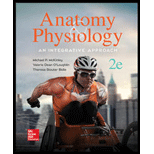
Concept explainers
Examining the superficial anatomic markings and internal body structures as they relate to the covering skin is called
- a. regional anatomy.
- b. surface anatomy.
- c. pathologic anatomy.
- d. comparative anatomy.
Introduction:
The study of forms and structure is known as Anatomy. It is derived from “anatomy” the Greek word which means to dissect. The scientists who study the forms and structure of organisms are known as anatomists.
Answer to Problem 1DYKB
Correct answer:
Surface anatomy is the superficial anatomic marking and internal body structures as they relate to skin covering. Therefore, option b. is correct.
Explanation of Solution
Reason for the correct statement:
Option b. is given as “surface anatomy”. The Gross anatomy is the part of the anatomy that deals with the investigation of “structure and relationship of parts of the body that are visible” such as stomach, heart, kidney, brain. This may be approached in several ways which include systemic anatomy, regional anatomy, surface anatomy, comparative anatomy, and embryology. Surface anatomy focuses both on internal structure and superficial anatomical marking that relates to the skin covering them. Hence, surface anatomy is one of the several approaches that examine both internal structure and superficial anatomical marking that relates to skin that covers them.
Hence, option b. is correct.
Reasons for the incorrect statements:
Option a. is given as “regional anatomy”. It examines all of the structure that is present in the particular region of the body as a unit. Hence, option a. is incorrect
Option c. is given as “pathologic anatomy”. It examines the anatomical changes resulting from disease. Hence, option c. is incorrect.
Option d. is given as “comparative anatomy”. It examines the differences and similarities between anatomies of different species. Hence, option d. is incorrect.
Hence, options a., c., and d. are incorrect.
The branch of anatomy that examines both internal structure and superficial anatomical marking that relates to skin that covers them is known as surface anatomy.
Want to see more full solutions like this?
Chapter 1 Solutions
Anatomy & Physiology: An Integrative Approach
- Selection of Traits What adaptations do scavengers have for locating and feeding on prey? What adaptations do predators have for capturing and consuming prey?arrow_forwardCompetition Between Species What natural processes limit populations from growing too large? What are some resources organisms can compete over in their natural habitat?arrow_forwardSpecies Interactions Explain how predators, prey and scavengers interact. Explain whether predators and scavengers are necessary or beneficial for an ecosystem.arrow_forward
- magine that you are conducting research on fruit type and seed dispersal. You submitted a paper to a peer-reviewed journal that addresses the factors that impact fruit type and seed dispersal mechanisms in plants of Central America. The editor of the journal communicates that your paper may be published if you make ‘minor revisions’ to the document. Describe two characteristics that you would expect in seeds that are dispersed by the wind. Contrast this with what you would expect for seeds that are gathered, buried or eaten by animals, and explain why they are different. (Editor’s note: Providing this information in your discussion will help readers to consider the significance of the research).arrow_forwardWhat is the difference between Uniporters, Symporters and Antiporters? Which of these are examples of active transport?arrow_forwardWhat are coupled transporters?arrow_forward
- How do histamine and prostaglandins help in the mobilization of leukocytes to an injury site? What are chemotactic factors? How do they affect inflammation process?arrow_forwardCompare and contrast neutrophils and macrophages. Describe two ways they are different and two ways they are similar.arrow_forwardDescribe the effects of three cytokines (not involved in the initial inflammation response). What cells release them?arrow_forward
 Comprehensive Medical Assisting: Administrative a...NursingISBN:9781305964792Author:Wilburta Q. Lindh, Carol D. Tamparo, Barbara M. Dahl, Julie Morris, Cindy CorreaPublisher:Cengage Learning
Comprehensive Medical Assisting: Administrative a...NursingISBN:9781305964792Author:Wilburta Q. Lindh, Carol D. Tamparo, Barbara M. Dahl, Julie Morris, Cindy CorreaPublisher:Cengage Learning




